会计英语 注册会计师讲义
注册会计师-《会计》英语基础讲义-专题十 所得税(6页)
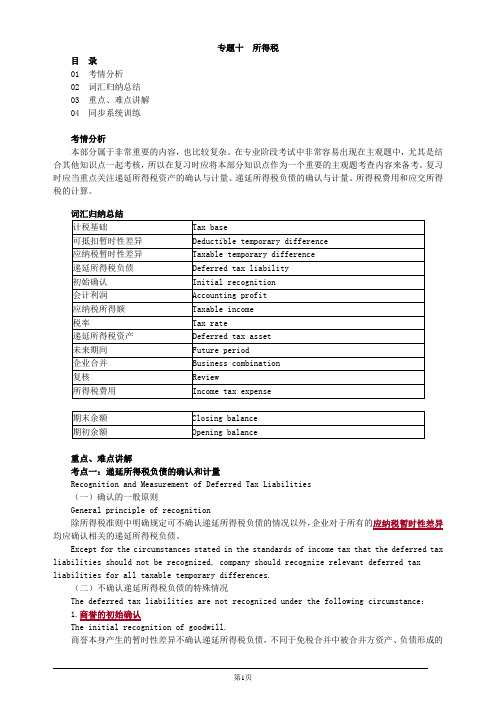
专题十所得税目录01 考情分析02 词汇归纳总结03 重点、难点讲解04 同步系统训练考情分析本部分属于非常重要的内容,也比较复杂。
在专业阶段考试中非常容易出现在主观题中,尤其是结合其他知识点一起考核,所以在复习时应将本部分知识点作为一个重要的主观题考查内容来备考。
复习时应当重点关注递延所得税资产的确认与计量、递延所得税负债的确认与计量、所得税费用和应交所得税的计算。
词汇归纳总结重点、难点讲解考点一:递延所得税负债的确认和计量Recognition and Measurement of Deferred Tax Liabilities(一)确认的一般原则General principle of recognition除所得税准则中明确规定可不确认递延所得税负债的情况以外,企业对于所有的应纳税暂时性差异均应确认相关的递延所得税负债。
Except for the circumstances stated in the standards of income tax that the deferred tax liabilities should not be recognized, company should recognize relevant deferred tax liabilities for all taxable temporary differences.(二)不确认递延所得税负债的特殊情况The deferred tax liabilities are not recognized under the following circumstance:1.商誉的初始确认The initial recognition of goodwill.商誉本身产生的暂时性差异不确认递延所得税负债,不同于免税合并中被合并方资产、负债形成的暂时性差异。
The temporary differences caused by goodwill are not recognized as deferred tax liabilities, it is different from the temporary difference arising from asset and liability of combined party in tax free combination.2.除企业合并以外的其他交易或事项中,如果该项交易或事项发生时既不影响会计利润,也不影响应纳税所得额,则所产生的资产、负债的初始确认金额与其计税基础不同,形成应纳税暂时性差异的,交易或事项发生时不确认相应的递延所得税负债。
2019注会会计英语基础讲义
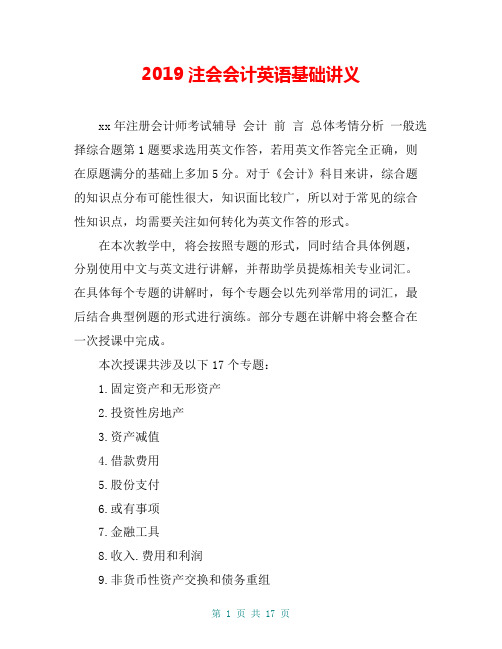
2019注会会计英语基础讲义xx年注册会计师考试辅导会计前言总体考情分析一般选择综合题第1题要求选用英文作答,若用英文作答完全正确,则在原题满分的基础上多加5分。
对于《会计》科目来讲,综合题的知识点分布可能性很大,知识面比较广,所以对于常见的综合性知识点,均需要关注如何转化为英文作答的形式。
在本次教学中, 将会按照专题的形式,同时结合具体例题,分别使用中文与英文进行讲解,并帮助学员提炼相关专业词汇。
在具体每个专题的讲解时,每个专题会以先列举常用的词汇,最后结合典型例题的形式进行演练。
部分专题在讲解中将会整合在一次授课中完成。
本次授课共涉及以下17个专题:1.固定资产和无形资产2.投资性房地产3.资产减值4.借款费用5.股份支付6.或有事项7.金融工具8.收入.费用和利润9.非货币性资产交换和债务重组10.所得税11.外币折算12.租赁13.会计政策变更.估计变更.差错更正14.资产负债表日后事项15.长期股权投资和企业合并16.合并财务报表17.每股收益课堂教学形式由于自xx年起注册会计师考试采用机考的形式,因此同学们在运用英语进行综合题目作答的过程中能够快速准确的在电脑上输入答案是得分的前提。
为了提高同学们快速输入英语答案的准确性,本门课程需要同学们在上课过程中跟随主讲老师将英文部分内容在Word文档中输出,以达到对单词的准确拼写以及对语法句型熟悉掌握的目的。
专题一固定资产和无形资产目录 01 考情分析 02 词汇归纳总结03 重点.难点讲解 04 同步系统训练考情分析有关固定资产和无形资产的内容在注会考试中属于非常重要的基础知识,可能并不单独以主观题形式进行考查,但是专业阶段主观题所考查的知识点中一般都会穿插其相关内容。
如与借款费用.会计估计变更及差错更正等内容的结合。
因此,要给予一定的重视。
词汇归纳总结固定资产 Fixed asset 无形资产 Intangible asset 预定可使用状态 Expected conditions for use 运费 Freight 装卸费Loading fee 具有融资性质 With financing nature 实际上;生效 In effect 依照 According to/ In accordance with 直线法Straight line method 工作量法 Unit of production method 双倍余额递减法 Double declining balance method 年数总和法Sum of the years digits method 累计折旧 Accumulated depreciation 后续支出 Subsequent expenditure 更新改造Transformation and renovation 修理费用 Repair expenditure 管理费用 General and administrative expense 销售费用Selling expense 研究阶段 Research stage 开发阶段Development stage 摊销 Amortization 确定 Determine 在建工程 Construction in process 预计使用寿命 Estimated useful life 特许权 Franchise right 保险费 Insurance expense 长期应付款 Long-term payable 专利权 Patent 研究开发费用Research and development cost 残值 Residual value 有形资产 Tangible asset 重点.难点讲解考点一:固定资产的初始计量 Initial Measurement of Fixed Assets1.外购固定资产 Purchased fixed assets 外购固定资产的成本,包括购买价款.相关税费.使固定资产达到预定可使用状态前所发生的可归属于该项资产的运输费.装卸费.安装费和专业人员服务费等。
CPA注册会计师会计讲义会计英语第十四章第十五章合并讲解

CPA注册会计师会计讲义会计英语第十四章第十五章合并讲解第十四章/第十五章合并讲解第14章资产负债表日后事项本部分内容在近几年专业阶段考试中也是主观题的热门考点,其经常通过与或有事项、资产减值、销售退回、前期差错等内容结合考查。
复习时应当重点注意日后调整事项与非调整事项的判断,日后调整事项的会计处理以及报表调整。
I. 资产负债表日后事项的分类Classification of Events after Balance Sheet Date资产负债表日后事项包括资产负债表日后调整事项和资产负债表日后非调整事项。
The events after the balance sheet date include the adjusting events and non-adjusting events after the balance sheet date.II. 资产负债表日后调整事项Adjusting Events after the Balance Sheet Date企业发生资产负债表日后调整事项,应当调整资产负债表日的财务报表。
An enterprise shall adjust its financial statements on the balance sheet date for any adjusting event occurring after the balance sheet date.III. 资产负债表日后非调整事项资产负债表日后发生的非调整事项,不应当调整资产负债表日的财务报表,应当在报表附注中披露每项重要的资产负债表日后非调整事项的性质、内容,及其对财务状况和经营成果的影响。
无法作出估计的,应当说明原因。
An enterprise may not adjust the financial statement on the balance sheet date for any non-adjusting event occurring after the balance sheet date while the nature, content and influence on financial position and operational result relating to materialnon-adjusting events which occur after balance sheet date should be disclosed in the notes to accounts, if the estimates could not be made, the reasons should be explained.第15章长期股权投资和企业合并本部分既是重点内容又是难点内容,从考试情况看,其经常在专业阶段的主观题中进行考查,所占分值较大,考生应全面熟练掌握。
会计英语注册会计师讲义
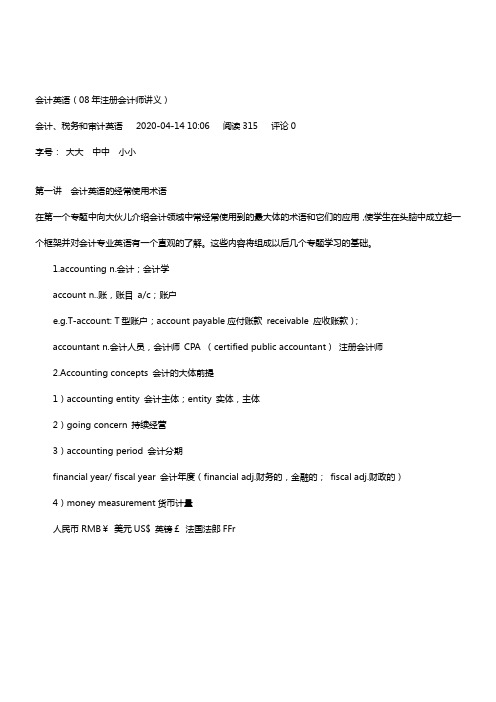
会计英语(08年注册会计师讲义)会计、税务和审计英语2020-04-14 10:06 阅读315 评论0字号:大大中中小小第一讲会计英语的经常使用术语在第一个专题中向大伙儿介绍会计领域中常经常使用到的最大体的术语和它们的应用,使学生在头脑中成立起一个框架并对会计专业英语有一个直观的了解。
这些内容将组成以后几个专题学习的基础。
1.accounting n.会计;会计学account n..账,账目a/c;账户e.g.T-account: T型账户;account payable应付账款receivable 应收账款);accountant n.会计人员,会计师CPA (certified public accountant)注册会计师2.Accounting concepts 会计的大体前提1)accounting entity 会计主体;entity 实体,主体2)going concern 持续经营3)accounting period 会计分期financial year/ fiscal year 会计年度(financial adj.财务的,金融的;fiscal adj.财政的)4)money measurement货币计量人民币RMB¥美元US$ 英镑£法国法郎FFr*权责发生制accrual basis.accrual n.本身是应计未付的意思,accrue v.应计未付,应计未收,e.g.accrued liabilities,应计未付欠债3.Quality of accounting information 会计信息质量要求(1)靠得住性reliability(2)相关性relevance(3)可明白得性understandability(4)可比性comparability(5)实质重于形式substance over form(6)重要性materiality(7)谨慎性prudence(8)及时性timeliness4.Elements of accounting会计要素1)Assets: 资产- current assets 流动资产cash and cash equivalents 现金及现金等价物(bank deposit)inventory存货receivable应收账款prepaid expense 预付费用- non-current assets 固定资产property (land and building)不动产, plant 厂房, equipment 设备(PPE)e.g.The total assets owned by Wilson company on December 31, 2006 was US$1,500,000.2)Liabilities: 欠债funds provided by the creditors. creditor债权人,赊销方- current liabilities 当期欠债non-current liabilities 长期欠债total liabilitiesaccount payable应付账款loan贷款advance from customers 预收款bond债券(由政府发行, government bond /treasury bond政府债券,国库券)debenture债券(由发行)3)Owners' equity: 所有者权益(Net assets)funds provided by the investors. Investor 投资者- paid in capital (contributed capital)实收资本- shares /capital stock (u.s.)股票retained earnings 留存收益同时记住几个单词dividend 分红beginning retained earnings ending retained earnings- reserve 储蓄金(资产重估储蓄金,股票溢价账户)e.g.The company offered/issued 10,000 shares at the price of US$2.30 each. 4)Revenue: 收入sales revenue销售收入interest revenue利息收入rent revenue租金收入5)Expense: 费用cost of sales销售本钱, wages expense工资费用6)Profit (income, gain):利润net profit, net income5.Financial statement 财务报表1)balance sheet 资产欠债表2)income statement 利润表3)statement of retained earnings 所有者权益变更表4)cash flow statement 现金流量表6.Accounting cycle1)journal entries 日记账general journal 总日记账general ledger 总分类账trial balance试算平稳表adjusting entries 调整分录adjusted trial balance调整后的试算平稳表Financial statements 财务报表closing entry 完结分录2)Dr.-Debit 借Cr.-Credit 贷Double-entry system 复式记账7.Exercise 练习1)purchases of inventory in cash for RMB¥3,000 现金人民币3,000元购买存货Dr.inventory 3,000 借:存货3,000Cr.cash 3,000 贷:现金3,0002)sales on account of US$10,000 赊销方式销售,收入10,000美元Dr.account receivable 10,000 借:应收账款10,000 Cr.sales revenue 10,000 贷:销售收入10,0003)paid RMB¥50,000 in salaries & wages 支付工资人民币50,000元Dr.wages & salaries expense 50,000 借:职工薪酬50,000Cr.bank deposit 50,000 贷:银行存款50,0004)cash sale of US$1,180 销售收入现金1,180美元Dr.cash 1,180 借:现金1,180Cr.sales revenue 1,180 贷:销售收入1,180 5)pre-paid insurance for US$12,000 预付保险费12,000美元Dr.prepaid insurance 12,000 借:预付保险12,000Cr.bank deposit 12,000 贷:银行存款12,000第二讲存货讲课内容和教学目标:本专题要紧教学与存货有关的英文术语,如期初和期末的存货的表达方式,和不同的企业中的各类存货形式。
注册会计师-《会计》英语基础讲义-专题七 金融工具(14页)
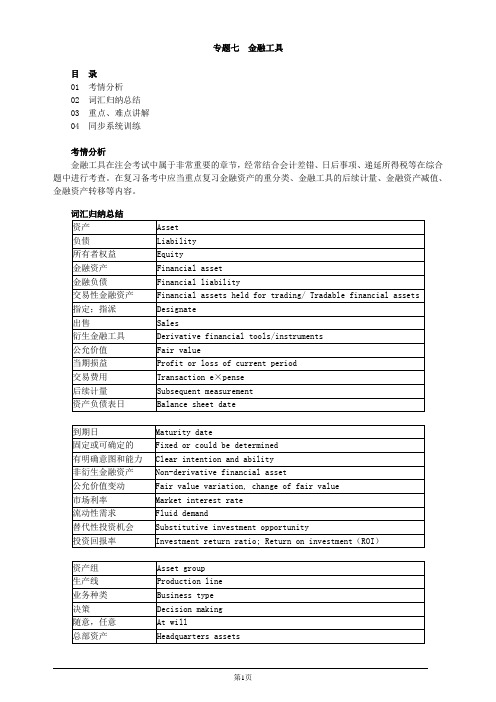
专题七金融工具目录01 考情分析02 词汇归纳总结03 重点、难点讲解04 同步系统训练考情分析金融工具在注会考试中属于非常重要的章节,经常结合会计差错、日后事项、递延所得税等在综合题中进行考查。
在复习备考中应当重点复习金融资产的重分类、金融工具的后续计量、金融资产减值、金融资产转移等内容。
词汇归纳总结重点、难点讲解考点一:金融资产和金融负债的分类和重分类(一)金融资产的分类The classification of financial assets金融资产一般划分为以下三类:Financial assets could be generally categorized into 3 groups:1.以摊余成本计量的金融资产;Financial assets measured at amortized cost金融资产同时符合下列条件的,应当分类为以摊余成本计量的资产:If the following conditions are satisfied at the same time, financial assets should beclassified as financial assets measured at amortized cost:(1)企业管理该金融资产的业务模式是以收取合同现金流量为目标;The business mode of managing this financial asset by the enterprise is collecting cash flow from the contract as the target.(2)该金融资产的合同条款规定,在特定日期产生的现金流量,仅为对本金和以未偿付本金金额为基础的利息的支付。
The contract terms of the financial asset stipulate that the cash flow generated on a specific date is only for the payment of principal and interest on the basis of outstanding principal amount.2.以公允价值计量且其变动计入其他综合收益的金融资产;Financial assets measured at fair value and changes recorded into other comprehensive income (或:Financial assets at fair value through other comprehensive income)金融资产同时符合下列条件的,应当分类为以公允价值计量且其变动计入其他综合收益的金融资产: If the following conditions are satisfied at the same time, financial assets should be classified as financial assets at fair value through other comprehensive income:(1)企业管理该金融资产的业务模式既以收取合同现金流量为目标又以出售该金融资产为目标;The business mode of managing this financial asset by the enterprise is not only collecting cash flow from the contract as the target but also selling the financial asset as the target.(2)该金融资产的合同条款规定,在特定日期产生的现金流量,仅为对本金和以未偿付本金金额为基础的利息的支付。
CPA 注册会计师 会计 讲义 会计英语 第六章 或有事项
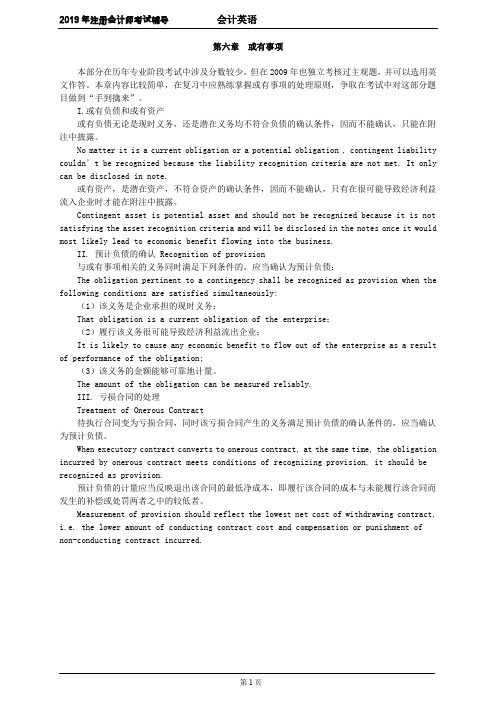
2019年注册会计师考试辅导会计英语第六章或有事项本部分在历年专业阶段考试中涉及分数较少,但在2009年也独立考核过主观题,并可以选用英文作答。
本章内容比较简单,在复习中应熟练掌握或有事项的处理原则,争取在考试中对这部分题目做到“手到擒来”。
I.或有负债和或有资产或有负债无论是现时义务,还是潜在义务均不符合负债的确认条件,因而不能确认,只能在附注中披露。
No matter it is a current obligation or a potential obligation , contingent liability couldn’t be recognized because the liability recognition criteria are not met. It only can be disclosed in note.或有资产,是潜在资产,不符合资产的确认条件,因而不能确认,只有在很可能导致经济利益流入企业时才能在附注中披露。
Contingent asset is potential asset and should not be recognized because it is not satisfying the asset recognition criteria and will be disclosed in the notes once it would most likely lead to economic benefit flowing into the business.II. 预计负债的确认 Recognition of provision与或有事项相关的义务同时满足下列条件的,应当确认为预计负债:The obligation pertinent to a contingency shall be recognized as provision when the following conditions are satisfied simultaneously:(1)该义务是企业承担的现时义务;That obligation is a current obligation of the enterprise;(2)履行该义务很可能导致经济利益流出企业;It is likely to cause any economic benefit to flow out of the enterprise as a result of performance of the obligation;(3)该义务的金额能够可靠地计量。
综合阶段英语学习讲义-注册会计师(CPA-)第12讲

5.、Porter‟s diamondPorter tried to answer the following questions:Why does a nation become the home base (总部, 根据地) for successful international competitors in an industry? Germany is renowned for car manufacture; Japan is prominent in consumer electronics (消费性电子产品).Why are firms based in a particular nation able to create and sustain competitive advantage against the world‟s best competitors in a particular field?Why is one country often the home of so many of an industry‟s world leaders? Porter called the answers to these questions the determinants (决定因素) of national competitive advantage. He suggested that there are four main factors which determine national competitive advantage and expressed them in the form of a diamond.迈克尔·波特识别出国家竞争优势的四个决定因素,构建了钻石模型。
Favorable factor conditions: physical resources such as land, minerals and weather;capital; human resources; knowledge and infrastructure.There must be a strong home market demand for the product or service.The success of an industry can be due to its suppliers and related industries. Organization goals can be determined by ownership structure.1. BenchmarkingBenchmarking is the process of systematic comparison of a service, practice or process. Its use is to provide a target for action in order to improve competitive position. 基准分析是企业和竞争对手在劳务、实践或流程等方面系统进行比较的过程。
会计英语基础讲义

3)贷款和应收款项;Loans and the accounts receivable; and4)可供出售金融资产。
Financial assets available for sale.一、以公允价值计量且其变动计入当期损益的金融资产Financial Assets Measured at Fair Value and Changes Recorded into Current Period Profit or Loss以公允价值计量且其变动计入当期损益的金融资产,可以进一步分为交易性金融资产和指定为以公允价值计量且其变动计入当期损益的金融资产。
Financial assets at fair value through profit or loss could be further divided into financial assets held for trading and financial assets that are designated as financial assets measured at fair value and the changes of which are recorded into current period profit or loss.金融资产满足下列条件之一的,应当划分为交易性金融资产:It should be classified as financial asset held for trading if one of the following conditions is met:(1)取得该金融资产的目的,主要是为了近期内出售。
The purpose of obtaining financial assets is to sell recently.(2)属于进行集中管理的可辨认金融工具组合的一部分,且有客观证据表明企业近期采用短期获利方式对该组合进行管理。
会计英语基础讲义

3)贷款和应收款项;Loans and the accounts receivable; and4)可供出售金融资产。
Financial assets available for sale.一、以公允价值计量且其变动计入当期损益的金融资产Financial Assets Measured at Fair Value and Changes Recorded into Current Period Profit or Loss以公允价值计量且其变动计入当期损益的金融资产,可以进一步分为交易性金融资产和指定为以公允价值计量且其变动计入当期损益的金融资产。
Financial assets at fair value through profit or loss could be further divided into financial assets held for trading and financial assets that are designated as financial assets measured at fair value and the changes of which are recorded into current period profit or loss.金融资产满足下列条件之一的,应当划分为交易性金融资产:It should be classified as financial asset held for trading if one of the following conditions is met:(1)取得该金融资产的目的,主要是为了近期内出售。
The purpose of obtaining financial assets is to sell recently.(2)属于进行集中管理的可辨认金融工具组合的一部分,且有客观证据表明企业近期采用短期获利方式对该组合进行管理。
注册会计师-《会计》英语基础讲义-专题一 固定资产和无形资产(8页)

专题一固定资产和无形资产目录01 考情分析02 词汇归纳总结03 重点、难点讲解04 同步系统训练考情分析有关固定资产和无形资产的内容在注会考试中属于非常重要的基础知识,可能并不单独以主观题形式进行考查,但是专业阶段主观题所考查的知识点中一般都会穿插其相关内容。
如与借款费用、会计估计变更及差错更正等内容的结合。
因此,要给予一定的重视。
词汇归纳总结重点、难点讲解考点一:固定资产的初始计量Initial Measurement of Fixed Assets1.外购固定资产 Purchased fixed assets外购固定资产的成本,包括购买价款、相关税费、使固定资产达到预定可使用状态前所发生的可归属于该项资产的运输费、装卸费、安装费和专业人员服务费等。
The cost of a purchased fixed asset consists of purchase price, relevant taxes, freights, loading fees, installment fees, professional service fees and other expenses that bring the fixed asset to the expected conditions for use and that may be relegated to the fixed asset.购买固定资产的价款超过正常信用条件延期支付,实质上具有融资性质的,固定资产的成本以购买价款的现值为基础确定。
If the payment for a fixed asset is delayed beyond the normal credit conditions and it is of financing nature in effect, the cost of the fixed asset shall be ascertained based on the present value of the purchase price.会计分录:Journal entry:借:固定资产(购买价款的现值)未确认融资费用(差额,应在信用期内采用实际利率法进行摊销)贷:长期应付款等(实际应支付价款)Dr:Fixed assets (the present value of the purchase price)Unrecognized financing expenses(the balance,which should be amortized within the credit period using the effective interest method)Cr:Long-term payable(the actual purchase price that should be paid)企业可能以一笔款项购入多项没有单独标价的固定资产。
CPA会计英语讲义
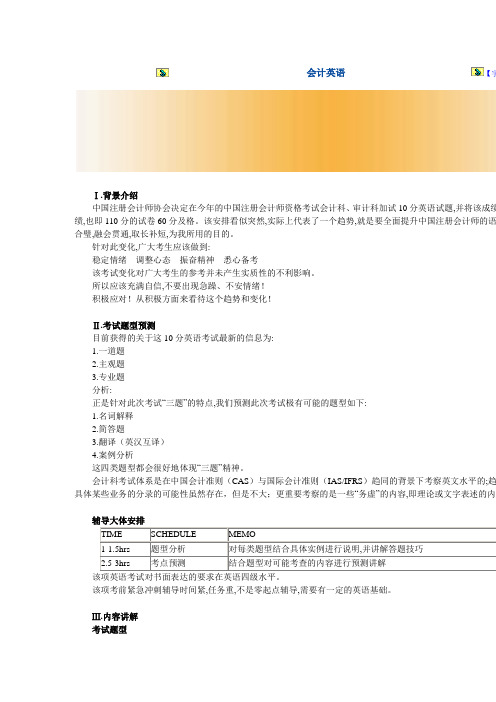
会计英语【字Ⅰ.背景介绍中国注册会计师协会决定在今年的中国注册会计师资格考试会计科、审计科加试10分英语试题,并将该成绩绩,也即110分的试卷60分及格。
该安排看似突然,实际上代表了一个趋势,就是要全面提升中国注册会计师的语合璧,融会贯通,取长补短,为我所用的目的。
针对此变化,广大考生应该做到:稳定情绪调整心态振奋精神悉心备考该考试变化对广大考生的参考并未产生实质性的不利影响。
所以应该充满自信,不要出现急躁、不安情绪!积极应对!从积极方面来看待这个趋势和变化!Ⅱ.考试题型预测目前获得的关于这10分英语考试最新的信息为:1.一道题2.主观题3.专业题分析:正是针对此次考试“三题”的特点,我们预测此次考试极有可能的题型如下:1.名词解释2.简答题3.翻译(英汉互译)4.案例分析这四类题型都会很好地体现“三题”精神。
会计科考试体系是在中国会计准则(CAS)与国际会计准则(IAS/IFRS)趋同的背景下考察英文水平的;趋具体某些业务的分录的可能性虽然存在,但是不大;更重要考察的是一些“务虚”的内容,即理论或文字表述的内容辅导大体安排TIME SCHEDULE MEMO1-1.5hrs题型分析对每类题型结合具体实例进行说明,并讲解答题技巧2.5-3hrs考点预测结合题型对可能考查的内容进行预测讲解该项英语考试对书面表达的要求在英语四级水平。
该项考前紧急冲刺辅导时间紧,任务重,不是零起点辅导,需要有一定的英语基础。
Ⅲ.内容讲解考试题型极有可能的题型如下:案例分析名词解释简答题翻译案例分析是在名词解释、简答题和翻译基础上构建起来的,是这三种题型的综合,因此,在分别介绍各种题型后及应对策略和答题技巧。
目前2006版中国会计准则(CAS 2006)和国际会计准则体系大体趋同,但在诸多细节上仍存在差异。
要么么是引进的新的理念。
对于会计科英语考试,主要从以下方面来准备:1.ACCOUNTING TERMS2.ACCOUNTING THEORIES3.ACCOUNITNG APPLICATIONS4.IAS/IFRS/CAS题型分析一、名词解释EXAMPLEFair Value[答疑编号31010101:针对该题提问]Solution:Fair value is the amount for which an asset could be exchanged or a liability settled between knowledgeable, will length transaction。
注会英语课件word资料26页
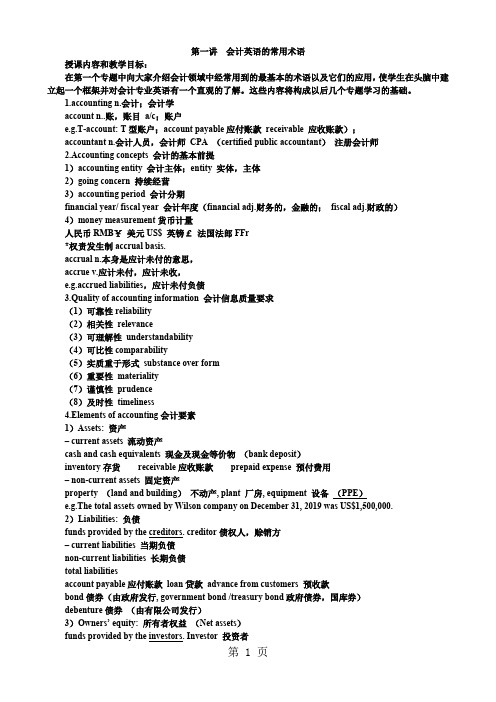
第一讲会计英语的常用术语授课内容和教学目标:在第一个专题中向大家介绍会计领域中经常用到的最基本的术语以及它们的应用,使学生在头脑中建立起一个框架并对会计专业英语有一个直观的了解。
这些内容将构成以后几个专题学习的基础。
1.accounting n.会计;会计学account n..账,账目a/c;账户e.g.T-account: T型账户;account payable应付账款receivable 应收账款);accountant n.会计人员,会计师CPA (certified public accountant)注册会计师2.Accounting concepts 会计的基本前提1)accounting entity 会计主体;entity 实体,主体2)going concern 持续经营3)accounting period 会计分期financial year/ fiscal year 会计年度(financial adj.财务的,金融的;fiscal adj.财政的)4)money measurement货币计量人民币RMB¥美元US$ 英镑£法国法郎FFr*权责发生制accrual basis.accrual n.本身是应计未付的意思,accrue v.应计未付,应计未收,e.g.accrued liabilities,应计未付负债3.Quality of accounting information 会计信息质量要求(1)可靠性reliability(2)相关性relevance(3)可理解性understandability(4)可比性comparability(5)实质重于形式substance over form(6)重要性materiality(7)谨慎性prudence(8)及时性timeliness4.Elements of accounting会计要素1)Assets: 资产– current assets 流动资产cash and cash equivalents 现金及现金等价物(bank deposit)inventory存货receivable应收账款prepaid expense 预付费用– non-current assets 固定资产property (land and building)不动产, plant 厂房, equipment 设备(PPE)e.g.The total assets owned by Wilson company on December 31, 2019 was US$1,500,000.2)Liabilities: 负债funds provided by the creditors. creditor债权人,赊销方– current liabilities 当期负债non-current liabilities 长期负债total liabilitiesaccount payable应付账款loan贷款advance from customers 预收款bond债券(由政府发行, government bond /treasury bond政府债券,国库券)debenture债券(由有限公司发行)3)Owners’ equity: 所有者权益(Net assets)funds provided by the investors. Investor 投资者– paid in capital (contributed capital)实收资本– shares /capital stock (u.s.)股票retained earnings 留存收益同时记住几个单词dividend 分红beginning retained earnings ending retained earnings– reserve 储备金(资产重估储备金,股票溢价账户)e.g.The company offered/issued 10,000 shares at the price of US$2.30 each.4)Revenue: 收入sales revenue销售收入interest revenue利息收入rent revenue租金收入5)Expense: 费用cost of sales销售成本, wages expense工资费用6)Profit (income, gain):利润net profit, net income5.Financial statement 财务报表1)balance sheet 资产负债表2)income statement 利润表3)statement of retained earnings 所有者权益变动表4)cash flow statement 现金流量表6.Accounting cycle1)journal entries 日记账general journal总日记账general ledger总分类账trial balance试算平衡表adjusting entries 调整分录adjusted trial balance调整后的试算平衡表Financial statements 财务报表closing entry 完结分录2)Dr.—Debit 借Cr.—Credit 贷Double-entry system 复式记账7.Exercise 练习1)purchases of inventory in cash for RMB¥3,000 现金人民币3,000元购买存货Dr.inventory 3,000借:存货3,000Cr.cash 3,000 贷:现金3,0002)sales on account of US$10,000 赊销方式销售,收入10,000美元Dr.account receivable 10,000借:应收账款10,000Cr.sales revenue 10,000 贷:销售收入10,0003)paid RMB¥50,000 in salaries & wages 支付工资人民币50,000元Dr.wages & salaries expense 50,000 借:职工薪酬50,000Cr.bank deposit 50,000贷:银行存款50,0004)cash sale of US$1,180 销售收入现金1,180美元Dr.cash 1,180 借:现金1,180Cr.sales revenue 1,180贷:销售收入1,1805)pre-paid insurance for US$12,000 预付保险费12,000美元Dr.prepaid insurance 12,000借:预付保险12,000Cr.bank deposit 12,000贷:银行存款12,000第二讲存货授课内容和教学目标:本专题主要讲授与存货有关的英文术语,如期初和期末的存货的表达方式,以及不同的企业中的各种存货形式。
CPA 注册会计师 会计 讲义 会计英语 第十二章 租赁
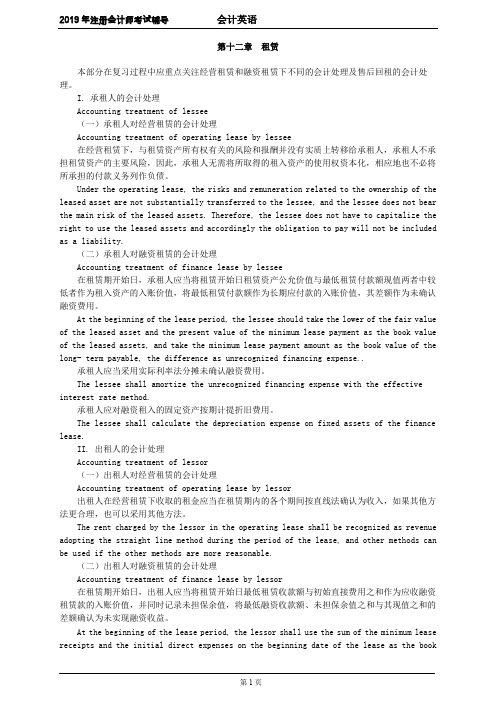
第十二章租赁本部分在复习过程中应重点关注经营租赁和融资租赁下不同的会计处理及售后回租的会计处理。
I. 承租人的会计处理Accounting treatment of lessee(一)承租人对经营租赁的会计处理Accounting treatment of operating lease by lessee在经营租赁下,与租赁资产所有权有关的风险和报酬并没有实质上转移给承租人,承租人不承担租赁资产的主要风险,因此,承租人无需将所取得的租入资产的使用权资本化,相应地也不必将所承担的付款义务列作负债。
Under the operating lease, the risks and remuneration related to the ownership of the leased asset are not substantially transferred to the lessee, and the lessee does not bear the main risk of the leased assets. Therefore, the lessee does not have to capitalize the right to use the leased assets and accordingly the obligation to pay will not be included as a liability.(二)承租人对融资租赁的会计处理Accounting treatment of finance lease by lessee在租赁期开始日,承租人应当将租赁开始日租赁资产公允价值与最低租赁付款额现值两者中较低者作为租入资产的入账价值,将最低租赁付款额作为长期应付款的入账价值,其差额作为未确认融资费用。
At the beginning of the lease period, the lessee should take the lower of the fair value of the leased asset and the present value of the minimum lease payment as the book value of the leased assets, and take the minimum lease payment amount as the book value of the long- term payable, the difference as unrecognized financing expense..承租人应当采用实际利率法分摊未确认融资费用。
CPA 注册会计师 会计 讲义 会计英语 第七章 金融工具
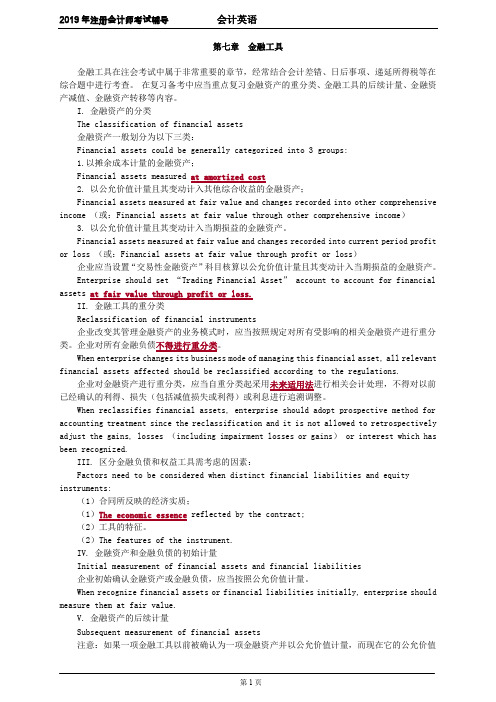
第七章金融工具金融工具在注会考试中属于非常重要的章节,经常结合会计差错、日后事项、递延所得税等在综合题中进行考查。
在复习备考中应当重点复习金融资产的重分类、金融工具的后续计量、金融资产减值、金融资产转移等内容。
I. 金融资产的分类The classification of financial assets金融资产一般划分为以下三类:Financial assets could be generally categorized into 3 groups:1.以摊余成本计量的金融资产;Financial assets measured at amortized cost2. 以公允价值计量且其变动计入其他综合收益的金融资产;Financial assets measured at fair value and changes recorded into other comprehensive income (或:Financial assets at fair value through other comprehensive income)3. 以公允价值计量且其变动计入当期损益的金融资产。
Financial assets measured at fair value and changes recorded into current period profit or loss (或:Financial assets at fair value through profit or loss)企业应当设置“交易性金融资产”科目核算以公允价值计量且其变动计入当期损益的金融资产。
Enterprise should set “Trading Financial Asset” account to account for financial assets at fair value through profit or loss.II. 金融工具的重分类Reclassification of financial instruments企业改变其管理金融资产的业务模式时,应当按照规定对所有受影响的相关金融资产进行重分类。
注册会计师考试英语讲义精品文档10页
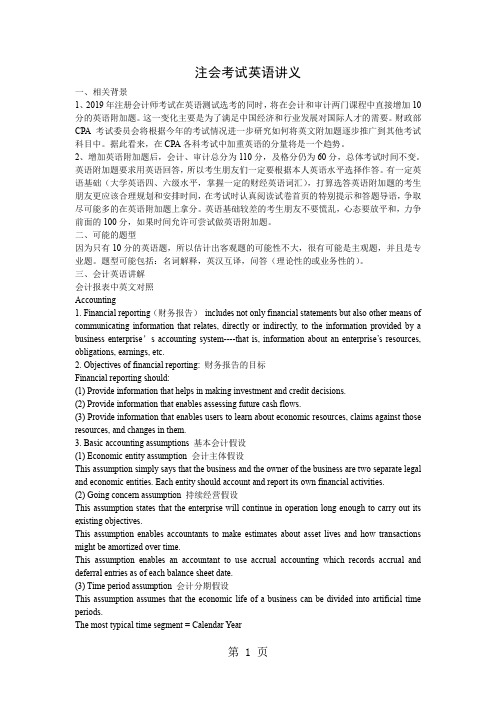
注会考试英语讲义一、相关背景1、2019年注册会计师考试在英语测试选考的同时,将在会计和审计两门课程中直接增加10分的英语附加题。
这一变化主要是为了满足中国经济和行业发展对国际人才的需要。
财政部CPA考试委员会将根据今年的考试情况进一步研究如何将英文附加题逐步推广到其他考试科目中。
据此看来,在CPA各科考试中加重英语的分量将是一个趋势。
2、增加英语附加题后,会计、审计总分为110分,及格分仍为60分,总体考试时间不变。
英语附加题要求用英语回答,所以考生朋友们一定要根据本人英语水平选择作答。
有一定英语基础(大学英语四、六级水平,掌握一定的财经英语词汇),打算选答英语附加题的考生朋友更应该合理规划和安排时间,在考试时认真阅读试卷首页的特别提示和答题导语,争取尽可能多的在英语附加题上拿分。
英语基础较差的考生朋友不要慌乱,心态要放平和,力争前面的100分,如果时间允许可尝试做英语附加题。
二、可能的题型因为只有10分的英语题,所以估计出客观题的可能性不大,很有可能是主观题,并且是专业题。
题型可能包括:名词解释,英汉互译,问答(理论性的或业务性的)。
三、会计英语讲解会计报表中英文对照Accounting1. Financial reporting(财务报告)includes not only financial statements but also other means of communicating information that relates, directly or indirectly, to the information provided by a business enterprise’s accounting system----that is, information abo ut an enterprise’s resources, obligations, earnings, etc.2. Objectives of financial reporting: 财务报告的目标Financial reporting should:(1) Provide information that helps in making investment and credit decisions.(2) Provide information that enables assessing future cash flows.(3) Provide information that enables users to learn about economic resources, claims against those resources, and changes in them.3. Basic accounting assumptions 基本会计假设(1) Economic entity assumption 会计主体假设This assumption simply says that the business and the owner of the business are two separate legal and economic entities. Each entity should account and report its own financial activities.(2) Going concern assumption 持续经营假设This assumption states that the enterprise will continue in operation long enough to carry out its existing objectives.This assumption enables accountants to make estimates about asset lives and how transactions might be amortized over time.This assumption enables an accountant to use accrual accounting which records accrual and deferral entries as of each balance sheet date.(3) Time period assumption 会计分期假设This assumption assumes that the economic life of a business can be divided into artificial time periods.The most typical time segment = Calendar YearNext most typical time segment = Fiscal Year(4) Monetary unit assumption 货币计量假设This assumption states that only transaction data that can be expressed in terms of money be included in the accounting records, and the unit of measure remains relatively constant over time in terms of purchasing power.In essence, this assumption disregards the effects of inflation or deflation in the economy in which the entity operates.This assumption provides support for the "Historical Cost" principle.4. Accrual-basis accounting 权责发生制会计5. Qualitative characteristics 会计信息质量特征(1) Reliability 可靠性For accounting information to be reliable, it must be dependable and trustworthy.Accounting information is reliable to the extend that it is:Verifiable: means that information has been objectively determined, arrived at, or created. More than one person could consider the facts of a situation and reach a similar conclusion. Representationally faithful: that something is what it is represented to be. For example, if a machine is listed as a fixed asset on the balance sheet, then the company can prove that the machine exists, is owned by the company, is in working condition, and is currently being used to support the revenue generating activities of the company.Neutral: means that information is presented in accordance with generally accepted accounting principles and practices, and without bias.(2) Relevance 相关性Relevant information is capable of making a difference in the decisions of users by helping them to evaluate the potential effects of past, present, or future transactions or other events on future cash flows (predictive value) or to confirm or correct their previous evaluations (confirmatory value).(3) Understandability 可理解性Understandability is the quality of information that enables users who have a reasonable knowledge of business and economic activities and financial reporting, and who study the information with reasonable diligence, to comprehend its meaning.(4) Comparability 可比性Comparability: suggests that accounting information that has been measured and reported in a similar manner by different enterprises should be capable of being compared because each of the enterprises is applying the same generally accepted accounting principles and practices. Consistency: suggests that an entity has used the same accounting principle or practice from one period to another, therefore, if the dollar amount reported for a category is different from one period to the next, then chances are that the difference is due to a change like an increase or decrease in sales volume rather than being due to a change in the method of calculating the dollar amount.(5) Substance over form 实质重于形式Substance over form emphasizes the economic substance of an event even though its legal form may provide a different result.It requires that business enterprise should perform accounting recognition, measurement and reporting in accordance with the economic substance rather than the legal form of an event ortransaction.(6) Materiality 重要性Information is material if its omission or misstatement could influence the resource allocation decisions that users make on the basis of an entity’s financial report. Materiality depends on the nature and amount of the item judged in the particular circumstances of its omission or misstatement. Deciding when an amount is material in relation to other amounts is a matter of judgment and professional expertise.(7) Conservatism 谨慎性Conservatism dictates that when in doubt, choose the method that will be least likely to overstate assets and income, and understate liabilities and expenses.(8) Timeliness 及时性Timeliness means having information available to decision makers before it loses its capacity to influence decisions. If information becomes available only after the time that a decision must be made, it has no capacity to influence that decision and thus lacks relevance.6. Basic accounting elements 基本会计要素(1) Asset 资产An asset is a resource that is owned or controlled by an enterprise as a result of past transactions or events and is expected to generate economic benefits to the enterprise.(2) Liability 负债A liability is a present obligation arising from past transactions or events which are expected to give rise to an outflow of economic benefits from the enterprise.A present obligation is a duty committed by the enterprise under current circumstances. Obligations that will result from the occurrence of future transactions or events are not present obligations and shall not be recognized as liabilities.(3) owners’equity 所有者权益Owners’ equity is the residual interest in the assets of an enterprise after deducting all its liabilities.Owners’ equity of a company is also known as shareholders’ equity.(4) Revenue 收入Revenue is the gross inflow of economic benefits derived from the course of ordinary activities that result in increases in equity, other than those relating to contributions from owners.(5) Expense 费用Expenses are the gross outflow of economic benefits resulted from the course of ordinary activities that resul t in decreases in owners’ equity, other than those relating to appropriations of profits to owners.(6) Profit 利润Profit is the operating result of an enterprise over a specific accounting period. Profit includes the net amount of revenue after deducting expenses, gains and losses directly recognized in profit of the current period, etc.7. Five measurement attributes 会计计量属性(1) Historical cost 历史成本Assets are recorded at the amount of cash or cash equivalents paid or the fair value of the consideration given to acquire them at the time of their acquisition. Liabilities are recorded at the amount of proceeds or assets received in exchange for the present obligation, or the amountpayable under contract for assuming the present obligation, or at the amount of cash or cash equivalents expected to be paid to satisfy the liability in the normal course of business.(2) Current replacement cost 现时重置成本Assets are carried at the amount of cash or cash equivalents that would have to be paid if a same or similar asset was acquired currently. Liabilities are carried at the amount of cash or cash equivalents that would be currently required to settle the obligation.(3) Net realizable value 可实现净值Assets are carried at the amount of cash or cash equivalents that could be obtained by selling the asset in the ordinary course of business, less the estimated costs of completion, the estimated selling costs and related tax payments.(4) Present value 现值Assets are carried at the present discounted value of the future net cash inflows that the item is expected to generate from its continuing use and ultimate disposal. Liabilities are carried at the present discounted value of the future net cash outflows that are expected to be required to settle the liabilities within the expected settlement period.(5) Fair value 公允价值Assets and liabilities are carried at the amount for which an asset could be exchanged, or a liability settled, between knowledgeable, willing parties in an arm’s length transaction.8. Financial statements 财务报表(1) Balance sheet 资产负债表A balance sheet is an accounting statement that reflects the financial position of an enterprise at a specific date.(2) Income statement 损益表An income statement is an accounting statement that reflects the operating results of an enterprise for a certain accounting period.(3) Statement of cash flows 现金流量表A cash flow statement is an accounting statement that reflects the inflows and outflows of cash and cash equivalents of an enterprise for a certain accounting period.(4) Statement of changes in owners’equity 所有者权益变动表A statement of changes in owners’ equity reports the changes in owners’ equity for a specific period of time.(5) Notes to financial statements 财务报表附注Notes to the accounting statements are further explanations of items presented in the accounting statements, and explanations of items not presented in the accounting statements, etc.9. Accounting entry 会计分录Debit: CashCredit: Common Stock10. Basic accounting equation 基本会计等式Assets = Liabilities + owners’ equi ty11. List of present and potential users of financial information 财务信息的使用者investors, creditors, employees, suppliers, customers, and governmental agencies.四、审计英语讲解Auditing1. Assurance engagements and external audit◇Materiality, true and fair presentation, reasonable assuranceMateriality is the magnitude of an omission or misstatement of accounting information that, in the light of surrounding circumstances, makes it probable that the judgment of a reasonable person relying on the information would have been changed or influenced by the omission or misstatement. An auditor must consider materiality both in (1) planning the audit and designing audit procedures and (2) evaluating audit results.◇Appointment, removal and resignation of auditors◇Types of opinion: standard unqualified opinion, Unqualified with additional explanatory language, qualified opinion, adverse opinion, disclaimer of opinion◇Professional ethics: independence, objectivity, integrity, professional competence, due care, confidentiality, professional behavior◇Engagement letter2. Planning and risk assessment◇General principles○Plan and perform audits with an attitude of professional skepticism○Audit risks = inherent risk ×control risk ×detection risk(1) Inherent risk refers to the likelihood of material misstatement of an assertion, assuming no related internal control. This risk differs by account and assertion.(2) Control risk is the likelihood that a material misstatement will not be prevented or detected ona timely basis by internal control. This risk is assessed using the results of tests of control.(3) Detection risk is the likelihood that an auditor’s procedures lead to an improper conclusion that no material misstatement exists in an assertion when in fact such a misstatement does exist. The auditor’s substantive tests are primarily relied upon to restrict detection risk.○Risk-based approach◇Understanding the entity and knowledge of the businessThe CPA should obtain a level of knowledge of the client’s business that will enable effective planning and performance of the audit in accordance with generally accepted auditing standards. This knowledge helps the auditor in(1) Identifying areas that may need special consideration(2) Assessing conditions under which accounting data are produced, processed, reviewed and accumulated(3) Evaluating accounting estimates for reasonableness (e.g., valuation of inventories, depreciation, allowance for doubtful accounts, percentage of completion of long-term contracts)(4) Evaluating the reasonableness of management representations(5) Making judgments about the appropriateness of the accounting principles applied and the adequacy of disclosures◇Assessing the risks of material misstatement and fraud○Materiality (level), tolerable error◇Analytical proceduresAnalytical procedures are normally used at three stages of the audit: (1) planning, (2) substantive testing, and (3) overall review at the conclusion of an audit. They are required during the planning and overall review stages.Analytical procedures used for 3 purposes:(1) Planning nature, timing, and extent of other auditing procedures(2) Substantive tests about particular assertions(3) Overall review in the final stage of audit◇Planning an audit◇Audit documentation: working papers◇The work of others○Rely on the work of experts○Rely on the work of internal audit3. Internal controlInternal control is a process effected by an entity’s board of directors, management, and other personnel—designed to provide reasonable assurance regarding the achievement of objectives in the following categories: (1) reliability of financial reporting, (2) effectiveness and efficiency of operations, and (3) compliance with applicable laws and regulations.Five components of internal control(1) control environment(2) risk assessment(3) control activities(4) information and communication(5) monitoring◇The evaluation of internal control systems○Tests of control○Substantive procedures (time, nature, extent)◇Transaction cycles: revenue, purchases, inventory, etc.4. Audit evidence◇Obtain sufficient, appropriate audit evidence◇Assertions contained in the financial statements: completeness, occurrence, existence, measurement, presentation and disclosure, rights and obligations, valuation◇The audit of specific items○Receivables: confirmation○Inventory: counting, cut-off, confirmation of inventory held by third parties○Payables: supplier statement reconciliation, confirmation○Bank and cash: bank confirmation◇Auditing sampling5. Review◇Subsequent events◇Going concern◇Management representations◇Audit finalization and the final review: unadjusted differences6. Reporting审计1.鉴证业务和外部审计◇重要性,真实、公允反映,合理保证◇注册会计师的聘用,解聘和辞职◇审计意见类型:标准无保留意见,带解释段的无保留意见,保留意见,否定意见,无法表示意见◇职业道德:独立、客观和公正,专业胜任能力,应有的关注,保密性,职业行为◇审计业务约定书2.审计计划和风险评估◇一般原则○计划和执行审计业务应保持应有的职业怀疑态度○审计风险=固有风险×控制风险×检查风险○风险导向型审计◇了解被审单位◇估计重大错报或舞弊的风险○重要性水平,可容忍误差◇分析性复核程序◇制定审计计划◇审计记录:工作底稿◇利用其他人的工作○利用专家工作○利用内部审计人员的工作3.内部控制◇内部控制系统评价○控制测试○实质性程序(时间,性质,范围)◇交易循环:收入循环、采购循环、存货循环,等等。
注册会计师考试CPA税法英语班课件讲义
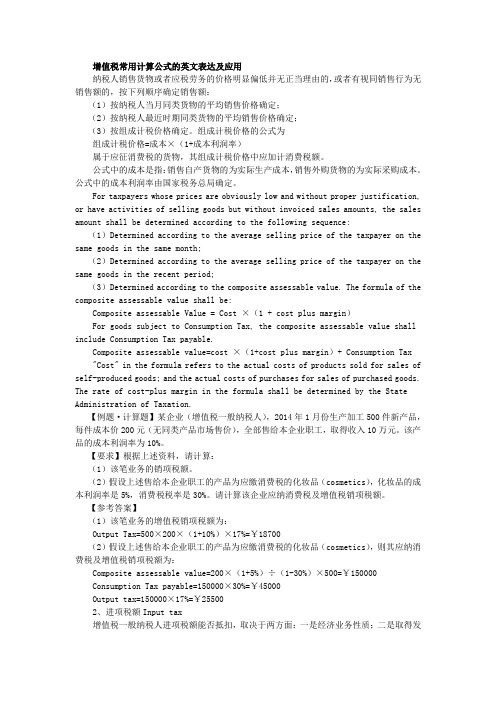
增值税常用计算公式的英文表达及应用纳税人销售货物或者应税劳务的价格明显偏低并无正当理由的,或者有视同销售行为无销售额的,按下列顺序确定销售额:(1)按纳税人当月同类货物的平均销售价格确定;(2)按纳税人最近时期同类货物的平均销售价格确定;(3)按组成计税价格确定。
组成计税价格的公式为组成计税价格=成本×(1+成本利润率)属于应征消费税的货物,其组成计税价格中应加计消费税额。
公式中的成本是指:销售自产货物的为实际生产成本,销售外购货物的为实际采购成本。
公式中的成本利润率由国家税务总局确定。
For taxpayers whose prices are obviously low and without proper justification, or have activities of selling goods but without invoiced sales amounts, the sales amount shall be determined according to the following sequence: (1)Determined according to the average selling price of the taxpayer on the same goods in the same month;(2)Determined according to the average selling price of the taxpayer on the same goods in the recent period;(3)Determined according to the composite assessable value. The formula of the composite assessable value shall be:Composite assessable Value = Cost ×(1 + cost plus margin)For goods subject to Consumption Tax, the composite assessable value shall include Consumption Tax payable.Composite assessable value=cost ×(1+cost plus margin)+ Consumption Tax "Cost" in the formula refers to the actual costs of products sold for sales of self-produced goods; and the actual costs of purchases for sales of purchased goods. The rate of cost-plus margin in the formula shall be determined by the State Administration of Taxation.【例题·计算题】某企业(增值税一般纳税人),2014年1月份生产加工500件新产品,每件成本价200元(无同类产品市场售价),全部售给本企业职工,取得收入10万元。
综合阶段英语学习讲义-注册会计师(CPA-)第06讲

综合阶段英语学习讲义-注册会计师(CPA-)第06讲Unit three Auditing审计1.风险评估2.风险应对3.销售与收款循环审计4.采购与付款循环审计5.特殊项⽬的考虑6.完成审计⼯作与出具审计报告⼀、Risk assessment、Risk response and Transaction cycle(⼀)Key words1. 财务报表审计总体⽬标:The objective of an external audit engagement is to enable the auditor to express an opinion on whether the financial statementsgive a true and fair view (or present fairly in all material respects)are prepared, in all material respects, in accordance with an applicablefinancial reporting framework.外部审计业务的⽬标就是使审计⼈员能够就财务报表是否在所有重⼤⽅⾯做出真实公允的反映,财务报表是否在所有重⼤⽅⾯按照适⽤的财务报告框架编制发表审计意见。
Misstatement, including omissions, are considered to be material if they, individually or in aggregate, could reasonably be expected to influence the economic decisions of users taken on the basis of the financial statements.如果错报(包括漏报)单独或汇总起来可能合理预期会影响财务报表使⽤者依据财务报表作出的经济决策,则认为错报是重⼤的。
- 1、下载文档前请自行甄别文档内容的完整性,平台不提供额外的编辑、内容补充、找答案等附加服务。
- 2、"仅部分预览"的文档,不可在线预览部分如存在完整性等问题,可反馈申请退款(可完整预览的文档不适用该条件!)。
- 3、如文档侵犯您的权益,请联系客服反馈,我们会尽快为您处理(人工客服工作时间:9:00-18:30)。
会计英语(08年注册会计师讲义)会计、税务和审计英语 2009-04-14 10:06 阅读315 评论0字号:大大中中小小第一讲会计英语的常用术语在第一个专题中向大家介绍会计领域中经常用到的最基本的术语以及它们的应用,使学生在头脑中建立起一个框架并对会计专业英语有一个直观的了解。
这些内容将构成以后几个专题学习的基础。
1.accounting n.会计;会计学account n..账,账目a/c;账户e.g.T-account: T型账户;account payable应付账款receivable 应收账款);accountant n.会计人员,会计师CPA (certified public accountant)注册会计师2.Accounting concepts 会计的基本前提1)accounting entity 会计主体;entity 实体,主体2)going concern 持续经营3)accounting period 会计分期financial year/ fiscal year 会计年度(financial adj.财务的,金融的;fiscal adj.财政的)4)money measurement货币计量人民币RMB¥美元US$ 英镑£法国法郎FFr*权责发生制accrual basis.accrual n.本身是应计未付的意思,accrue v.应计未付,应计未收,e.g.accrued liabilities,应计未付负债3.Quality of accounting information 会计信息质量要求(1)可靠性reliability(2)相关性relevance(3)可理解性understandability(4)可比性comparability(5)实质重于形式substance over form(6)重要性materiality(7)谨慎性prudence(8)及时性timeliness4.Elements of accounting会计要素1)Assets: 资产– current assets 流动资产cash and cash equivalents 现金及现金等价物(bank deposit)inventory存货receivable应收账款prepaid expense 预付费用– non-current assets 固定资产property (land and building)不动产, plant 厂房, equipment 设备(PPE)e.g.The total assets owned by Wilson company on December 31, 2006 was US$1,500,000.2)Liabilities: 负债funds provided by the creditors. creditor债权人,赊销方– current liabilities 当期负债non-current liabilities 长期负债total liabilitiesaccount payable应付账款loan贷款advance from customers 预收款bond债券(由政府发行, government bond /treasury bond政府债券,国库券)debenture债券(由有限公司发行)3)Owners’ equity: 所有者权益(Net assets)funds provided by the investors. Investor 投资者– paid in capital (contributed capital)实收资本– shares /capital stock (u.s.)股票retained earnings 留存收益同时记住几个单词dividend 分红beginning retained earnings ending retained earnings– reserve 储备金(资产重估储备金,股票溢价账户)e.g.The company offered/issued 10,000 shares at the price of US$2.30 each.4)Revenue: 收入sales revenue销售收入interest revenue利息收入rent revenue租金收入5)Expense: 费用cost of sales销售成本, wages expense工资费用6)Profit (income, gain):利润net profit, net income5.Financial statement 财务报表1)balance sheet 资产负债表2)income statement 利润表3)statement of retained earnings 所有者权益变动表4)cash flow statement 现金流量表6.Accounting cycle1)journal entries 日记账general journal总日记账general ledger总分类账trial balance试算平衡表adjusting entries 调整分录adjusted trial balance调整后的试算平衡表Financial statements 财务报表closing entry 完结分录2)Dr.—Debit 借Cr.—Credit 贷Double-entry system 复式记账7.Exercise 练习1)purchases of inventory in cash for RMB¥3,000 现金人民币3,000元购买存货Dr.inventory 3,000借:存货3,000Cr.cash 3,000 贷:现金3,0002)sales on account of US$10,000 赊销方式销售,收入10,000美元Dr.account receivable 10,000借:应收账款10,000 Cr.sales revenue 10,000 贷:销售收入10,0003)paid RMB¥50,000 in salaries & wages 支付工资人民币50,000元Dr.wages & salaries expense 50,000 借:职工薪酬50,000Cr.bank deposit 50,000贷:银行存款50,0004)cash sale of US$1,180 销售收入现金1,180美元Dr.cash 1,180 借:现金1,180Cr.sales revenue 1,180贷:销售收入1,1805)pre-paid insurance for US$12,000 预付保险费12,000美元Dr.prepaid insurance 12,000借:预付保险12,000Cr.bank deposit 12,000贷:银行存款12,000第二讲存货授课内容和教学目标:本专题主要讲授与存货有关的英文术语,如期初和期末的存货的表达方式,以及不同的企业中的各种存货形式。
其次,通过该专题的学习,使学生掌握对有关存货在买入时和卖出时的价值计量这一类英文题目的理解和解答,及与期末存货有关的会计处理方式的英文会计分录。
1.Inventory n. 存货,库存(c.f.stock英式英语用法)常见词组inventory turnover 存货周转率inventory control 存货控制beginning inventory初始存货ending inventory 期末存货take a physical inventory 盘库常见的存货形式:cost n. 成本,费用direct costs 直接成本indirect costs 间接成本fixed costs 固定成本cost accounting 成本会计v. 花费e.g. The office furniture of our company costs us $5,000.unit cost 单个成本total cost 总成本cost of sales (COS)= cost of goods sold(CGS)销货成本sales revenue 销售收入这两个词经常被放在一起做计算Lecture examples:①A company sold 15 computers for US$1000 each.某公司以1000美元一台的价格售出电脑共15台。
Sales revenue: US$1,000×15 = US$15,000②A company sold 15 computers costing US$800 each for total US$15,000.某公司销售出电脑15台,每台成本为800美元,共收入15,000美元。
cost of sales: US$800×15 = US$12,000Dr.bank deposit15,000借:银行存款15,000 Cr.sales revenue15,000贷:主营业务收入15,000 Dr.cost of sales12,000借:主营业务成本12,000 Cr.inventory--computer12,000贷:库存商品—电脑12,0003.初始成本计量The inventory should be measured at cost. Cost includes the following:采购成本purchase(price)运费freight 存储storing cost保险费insurance 税费tax 装卸费loading and unloading coste.g.During July, 2007, the company purchased 200 sets of sunshine brand printers at the price RMB¥410 each. RMB¥300 of freight were also paid.Dr. printer82,300Cr. bank deposit82,300借:固定资产—打印机82300贷:银行存款823004.发出存货的成本计量Specific identification 个别计价法unit cost × no. of unit = total costWeighted average 加权平均法First-in, First-out (FIFO)先进先出法Lower of cost or market rule (LCM rule)成本与市场孰低法Cost 成本market value (fair value)公允价值carrying value账面成本net realizable value可变现净值=estimated sale price估计售价-related costs and tax估计销售费用和税金* contract price合同价格sales price销售价格存货跌价准备的计提Dr. management cost—Dr. management cost-loss on market price decline of inventories 资产减值损失Cr. reserve for market price decline of inventories 存货跌价准备Lecture example:If the original cost of the inventory held by ABC company was US$2,000, and its estimated total sale price would be $2,100 and other expense for the sales would be $200.The net realizable value for those inventory: US$1,900=$2,100-$200Dr. management cost-loss on market price decline of inventories100Cr. reserve for market price decline of inventories100At the beginning of the year, Linda company held 1500 desk lamps costing RMB¥50.00 each. During the year it purchased an additional 500 lamps for RMB¥55.00 each. The company sold 1800 units.You are required to compute the cost of goods sold and ending inventory and make the necessary journal entry for the business assuming FIFO method are use.By the end of the year, it was reported that the market price of this type of lamp has declined to RMB¥52.00 each. You are also required to prepare the necessary journal entry on December 31 for the company.Dr:inventory27500Cr:bank deposit27500(500*55)②inventory sales (FIFO method will be used to calculate the CGS)cost of goods sold(CGS)=1500*50+300*55=91500ending inventory=1500*50+500*55-91500=11000Dr:bank deposit***Cr.sales revenue***Dr:cost of sales91500Cr. inventory--desk lamp91500③reserve for market price decline of inventoriesnet realizable value=200*52=10400Dr: management cost-loss on market price decline of inventorie600(11000-10400)Cr. reserve for market price decline of inventories600第三讲固定资产该专题内容主要介绍常用的与固定资产有关的英文词汇、短语和经济业务描述。
